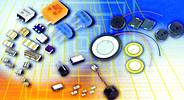

Piezoelectric ceramics are a type of multicrystal dielectric with a high dielectric constant. In operation, the piezoelectric effect causes a crystal to produce an electrical potential when subjected to mechanical vibration.
Conversely, the reverse piezoelectric effect causes the crystal to produce vibration when it is placed in an electric field.
Applications for piezoelectric ceramic technology are broad and diverse. The electrical to mechanical transducer can be applied to piezoelectric actuators, piezoelectric fans and ultrasonic cleaners whereas the mechanical to electrical transducer is at the heart of ultrasonic sensors, knock sensors, shock sensors and acceleration sensors. In terms of electronic component applications for piezoelectrics this includes ceramic filters, ceramic resonators, surface acoustic wave filters, along with many other niche areas.
Advantages
The advantages of piezoelectric ceramics include: high electromechanical transformation efficiency; high machinability; high stability; and low costs in volume production. In addition, a broad range of characteristics can be generated through different material compositions, so further expanding the application of the technology into a wide range of industries.
Piezotite
Murata's Piezotite material is used for a variety of component applications including actuators, transducers, filters, resonators and buzzers. The piezoelectric actuator ranges (P-5E, P-7 and P-7B) for example, provide precise displacement from 0,01 µm to several hundred µm, simply by controlling the applied voltage.
Applications for these devices include tracking adjustment of VCR heads, focus adjustment of VCR cameras, shutter drives of cameras and ink jet printers. Applications can also be found in the industrial and instrumentation markets.
Murata's Piezotite ceramic sensor range includes moulded underwater transducers, typically used in fish finders and depth sounders. The device emits an ultrasonic wave into the water and the appropriate receiving device can detect the reflected wave.
Ultrasonic sensors (MA40 series) are built using either an open or closed structure, which is compact and light weight, offering high sensitivity and sound pressure. Waterproof and high frequency versions are also available. Applications for these sensors include burglar alarms, range finders, automatic doors, automatic rear sonar, parking meters and remote control devices.
The PKGS series of shock sensors consist of an acceleration sensor with two terminals. The device is used to detect acceleration and/or shock applied from the outside, and converts this energy to an electrical signal. The surface mount devices feature high sensitivity and excellent durability. For all applications the axis of detection can be changed (either X, Y or Z) so that the appropriate shock sensor can be selected. For other applications, such as car burglar alarms, intruder sensors and vibration sensors for car audio equipment, Murata offers the PKS1 range of shock sensors. The piezoelectric element produces a voltage that is proportional to the impact or vibration to which it is exposed. The impact energy again being converted to an electrical signal.
Other application specific piezoelectric ceramic sensors have been developed by Murata, including knock sensors for car engines and ultrasonic bubble sensors for vending machines.

© Technews Publishing (Pty) Ltd | All Rights Reserved